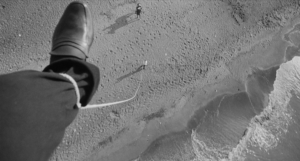– Orson Welles
Harsh, but sweet, but also harsh, Mr. Welles.
Eight and a Half is a perfect example of therapeutic art making. How can one turn a personal and artistic turmoil into film? Be honest. Painfully honest.
The opening sequence perfectly illustrates the difference between Eight and a Half and all the previous films we watched in class.
Stuck in the traffic, Guido can’t move. He starts suffocating from the smoke that appeared in the car. No one helps him. He proceeds to fly away, in peace. He escapes his anxiety through dreams and creative process. He sees the final stage of the film. He can almost reach it, and yet he’s being pulled down. Back to square one.
Compared to previous films we’ve seen, Fellini goes into more personal experience, rather than trying to define industry as a whole. It is definitely noted, that the way film business works often stands in the way of creating. But he also goes beyond those ideas. Fellini’s past and present are being studied by Fellini himself. Auto-ethnographical research in the form of 2 hour film, that seeks to find the truth. Both artistic and personal.
As one cannot exist without the other
.

